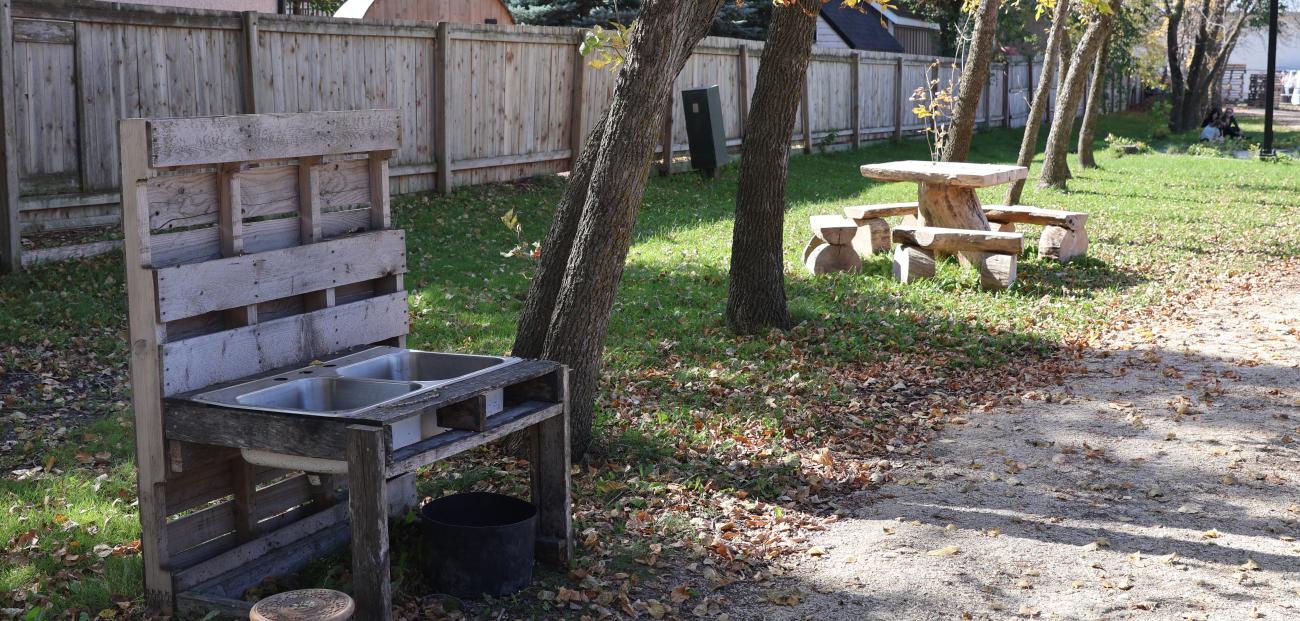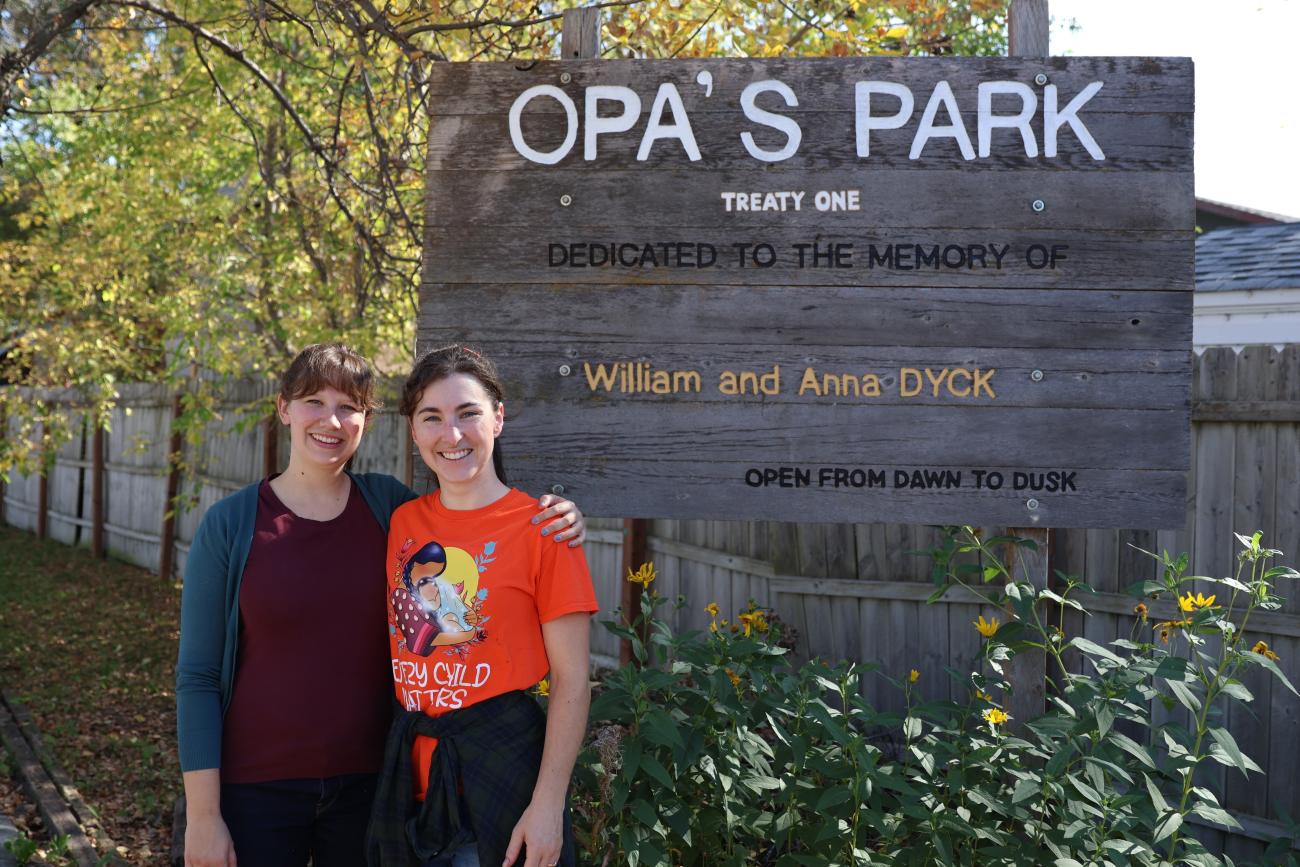For the past three years, a group of locals has been actively at work to bring new life and vibrancy to a once-neglected Niverville park. On October 10, they hope the entire community will join them for the grand re-opening of Opa’s Park.
Opa’s Park is located in a well-protected greenspace adjacent to Roselawn Bay and Edelweiss Crescent. To the north of the park lies the Wm. Dyck & Sons lumberyard and the businesses of 10 Cedar Drive.
Access to the park can be found along Roselawn Bay and the southernmost fence line of the 10 Cedar Drive parking lot.
Festivities will begin at 4:00 p.m. with a brief program, followed by a self-guided tour of the newly restored park, bouncy castle entertainment, and a hog roast dinner.
Beth Downey is the original champion of the restoration project. Growing up on Roselawn Bay, Opa’s Park was a much-loved playground for her.
“When I was a kid, this park had newish swings and two great big play structures in it, in addition to a basketball court,” Downey says. “It was a hub of activity with all the kids on Edelweiss and Roselawn. It backed onto half a dozen moms’ windows and was extremely safe and well-loved.”
Today, Downey and her partner are raising their own children on Roselawn Bay. After the birth of their first, Downey decided her kids should have the same experience she had, as well as all the other kids who inhabit the area.
Unfortunately, the park’s use had declined with generational changes in the neighbourhood. The play structures deteriorated and were removed and a general sense of neglect took over.
“The place flooded every year because the grading wasn’t correct,” Downey says. “There was a ton of garbage blown in from adjacent [commercial properties]. It became a garbage and drug [use] trap.”
With permission from town council, Downey and a small team of volunteers jumped into the daunting project.
Early on, a service gate was installed in the chain link fence, allowing easy access for landscaping equipment. One half of the park was then completely relandscaped, significantly improving drainage.
Of primary importance to Downey and the rest of the crew was creating a mobility-friendly space.
The access path from Roselawn Bay was undergirded with an improved gravel surface and then continued from one end of the park to the other. This pathway also connects every single play feature throughout, including the basketball court.
“That’s now the first accessible court in Niverville,” says Downey. “If you go by power chair or wheelchair, you can shoot hoops there. I don’t think that exists anywhere else in town.”
Lining the path are four new overhead solar lights, providing extra nighttime safety.
Downey’s goal with the restoration was to encourage, as much as possible, nature play. So you’ll find a rock spiral embedded in the landscape to encourage balancing skills. With her own hands, Downey constructed a mud kitchen and weather station which encourages learning.
Next to the mud kitchen sits a miniature timber picnic table with stools, constructed and donated by a Niverville resident.
Downey’s been encouraged to see other accoutrements show up, too, thanks to local donors, including a weathervane, saucer swing, and mini basketball hoop.
Already the sensory garden installed just a couple of years ago is producing strawberries and ground cherries for kids to enjoy as they ripen. Plants of differing textures and perfumes have also been thoughtfully incorporated, drawing in pollinators.

The mud kitchen at Opa's Park.
Not far away is one of the park’s most dominant features, the prairie garden and learning circle. This labour of love took hundreds of hours and many volunteers to plant, water, and weed.
Emma Bergen was one of those volunteers.
“I think some people walk by it and think it looks all shaggy and wild,” Bergen muses. “But [full appreciation] comes from knowing what plants are what, and walking through and identifying things. Like, the Bergamot smells amazing! I’ve seen more native ladybugs living in this garden than I’ve seen on my [vegetable] farm.”
The learning circle is a hardscaped sphere that makes good use of reclaimed brick from Providence University College.
Future additions will include a crescent shaped bench and oak stump stools. Downey anticipates this will be a perfect location for Indigenous teachings to take place. There’d be enough room here for a temporary teepee, if desired.
Even so, the space is already being put to use by local teachers and their classrooms.
Also new this summer was the installation of a Purple Martin house to entice wildlife back.
“How do you know when a rewilding project has been successful?” Downey asks. “We talked about this with [with a native plant expert] and she said, ‘When the birds come back.’ They are a keystone species and kind of the marker of health. This fall, I have seen a completely different combination of songbirds spending time here, stocking up on the seedheads [growing in] the prairie garden ahead of winter migration.”
One final item will complete the restoration project: the addition of interpretive signage. In the meantime, the original Opa’s Park sign received a much-needed makeover and stands proud at the west entry to the park.
“One of the things that was missing from the sign is the fact that this is Treaty 1 land,” says Downey. “Now that’s on the sign as well and it conveys, I think, that this park is a nature playground and an outdoor classroom, a place for learning from and improving our relationship with nature.”
Downey recognizes the many participants who have helped carry out her dream and is glad for each one. The town spent countless hours pursuing grant funding on her behalf and companies like Trotco Electric discounted their fees for the electrical installation.
The Fast family, whose ancestors established Opa’s Park in the first place, were significant donors, along with many others.
In support of the grand opening, Danny’s Whole Hog and Your Grocery People have stepped up to provide the food.
The Opa’s Park committee will accept dinner donations at the event for those who can support.
“It’s a pay-what-you-can kind of thing,” Downey says. “All the proceeds go towards further development here in the park.


